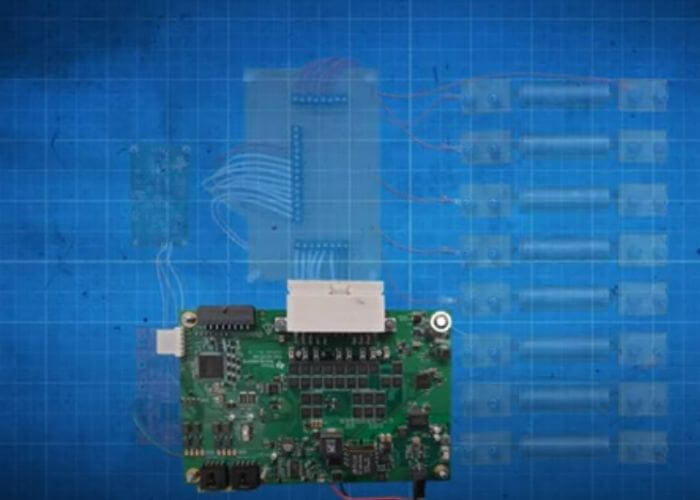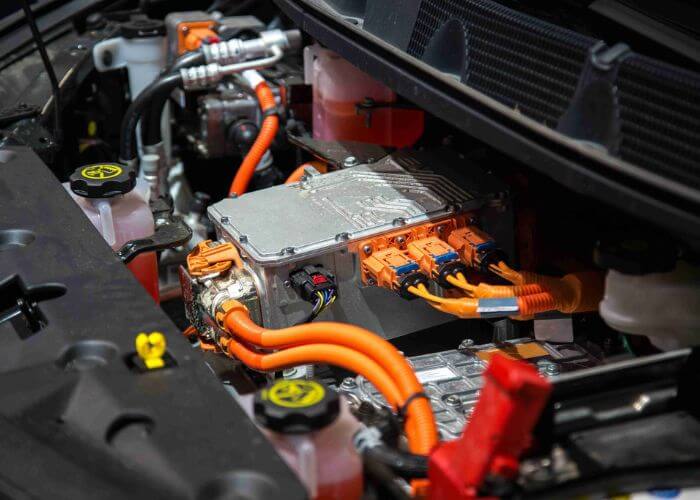The EV battery management system is a critical component of any electric vehicle. It ensures that the batteries are adequately charged and discharged while protecting them from damage. The BMS can be divided into two parts: the control unit and the sensing unit.

The control unit manages the charging and discharging of the batteries, while the sensing unit monitors their condition. The new EV Battery Technology is a high-tech, rechargeable battery that powers electric vehicles (EVs).
The average person doesn’t know much about their car’s engine. The same can be said for the average person’s knowledge of their car’s battery management system (BMS). A BMS ensures that a vehicle’s battery pack stays within safe operating parameters. It does this by constantly monitoring the pack’s cells and balance-charging them as needed.
The BMS is even more important when it comes to electric vehicles (EVs). That’s because EVs rely on large battery packs to power their motors, and these packs can be expensive to replace if they’re damaged. A good BMS can help extend the life of an EV’s battery pack by keeping it properly charged and balanced.
So how does a typical EV BMS work?
- First, each cell in the pack is monitored for voltage and temperature. If any cell gets too hot or the voltage gets too low, the BMS will take action to correct the problem.
- Second, the BMS constantly monitors the overall capacity of the pack and balances the cells as needed to ensure that they all have equal capacity. This helps prevent any one cell from being overworked or damaged. A good EV BMS can make a big difference in safety and longevity.
So if you’re driving an electric vehicle, ask your dealer or mechanic about its BMS – it could save you a lot of money down the road!
What is Battery Management System for Electric Vehicles?
The electric vehicle battery management system (BMS) is a critical component in the safe operation of an electric vehicle. The BMS monitors and manages the health of the batteries, ensuring that they operate within their optimal range. It also protects the batteries from overcharging or deep discharge, damaging them.
The BMS comprises several key components:
| Battery pack | This contains individual battery cells that store energy. |
| Battery controller | This regulates the energy flow between the battery pack and the rest of the electric vehicle system. |
| Temperature sensor | This monitors the battery pack’s temperature and ensures it remains within its safe operating range. |
| Voltage sensor | This measures the voltage of each cell in the battery pack and ensures that they are balanced. This is important to prevent overcharging or deep discharge, damaging cells. |
The BMS constantly monitors these parameters and makes adjustments to ensure that the batteries operate safely and efficiently. For example, if one cell in a battery pack is overcharged, the BMS will shut off charging to that cell until it returns to its average voltage level. This prevents damage to the cell and extends its life.
Battery Management System for Electric Vehicle?

Electric vehicle battery management systems (EV BMS) are designed to protect the battery pack, optimize energy utilization, and extend the life of the batteries. A typical EV BMS consists of a control unit, sensors, and actuators. The control unit monitors and manages the charging and discharging of the batteries.
It also regulates the temperature of the battery pack to ensure safe operation. Sensors monitor various parameters such as voltage, current, temperature, and state-of-charge (SOC). Actuators control things like charge/discharge current and cooling fans.
The main goal of an EV BMS is to protect the battery pack from damage due to overcharging, deep discharge, overheating, or other conditions that could shorten its life or cause a safety hazard.
To achieve this goal, EV BMS typically has some combination of these features:
Overcharging Protection
Overcharge protection prevents the battery pack from being charged above its maximum voltage level.
Overcharging can damage cells and shorten their lifespan. Deep discharge protection prevents the battery pack from being discharged below its minimum voltage level. Deep discharges can also damage cells and shorten their lifespan.
Temperature Monitoring
Temperature monitoring: This helps prevent overheating, which can damage cells and potentially cause a fire hazard.
Battery Management System for Electric Vehicle
As the number of electric vehicles (EVs) on the road continues to grow, so does the need for an effective battery management system (BMS). A BMS is responsible for ensuring that a vehicle’s batteries are adequately charged and discharged, which maximizes its lifespan and performance.
There are a few key components that make up a typical BMS:
| Battery packs | These are the actual batteries that power an EV. Most EVs use lithium-ion battery packs, although some older models may still use lead-acid batteries. |
| Battery cells | The individual cells within a battery pack. Each cell has its own voltage and current rating, which the BMS must monitor. Charging System: The charging system provides power to charge the battery pack(s). Depending on the charger, this can be either AC or DC power. |
| Controller | The controller is the brain of the operation, monitoring all the different voltages and currents throughout the system and ensuring everything is running smoothly. It also manages any safety features that may be built into the BMS. |
Battery Management System Lithium-Ion
As the world moves away from fossil fuels and towards renewable energy, battery management systems (BMS) are becoming more critical.
A BMS is a system that helps to maintain the performance of a lithium-ion battery pack by monitoring the individual cells in the pack and ensuring they are all working together efficiently. Lithium-ion batteries are made up of several smaller cells, each with its own voltage level.
The voltage levels of all the cells in a pack must be closely monitored, so they do not get too low or too high. If one cell in a pack gets too low, it can drag down the others and cause the entire pack to fail. Similarly, if one cell gets too high, it can overheat and damage the other cells in the pack.
A good BMS will monitor the voltage levels of all the cells in a pack and make sure they stay within safe limits. It will also balance the load between different cells so that no single cell is overloaded or underused. This ensures that each cell in a pack lasts as long as possible and that the entire pack continues to perform at its best for as long as possible. Without the BMS, the lithium-ion battery will overcharge and might explode.
Battery Management System LiFepO4
Lithium-ion batteries are the most common type used in today’s handheld electronic devices. Many of these devices, such as cell phones and laptops, use lithium-ion batteries because they are lightweight and have a high energy density. However, lithium-ion batteries can be expensive and have a limited lifespan.
- This is where Battery Management Systems (BMS) come in. A BMS is a system that monitors and manages the charging and discharging of a lithium-ion battery. BMS is used in various applications, including electric vehicles, UPS systems, and portable electronic devices.
- A typical BMS includes a control unit, sensors, and a communications interface. The control unit regulates the charging and discharging of the battery based on information received from the sensors. The sensors monitor temperature, voltage, current, and capacity.
- The communications interface allows the BMS to communicate with other devices, such as chargers or displays. BMS can extend the life of a lithium-ion battery by preventing overcharging or deep discharge. They can also improve safety by monitoring for abnormal conditions such as excessive heat or overcurrents.
In some cases, a BMS may also provide features such as data logging or remote monitoring/control.
Battery Management System Project
A battery management system (BMS) is a system that manages a rechargeable battery (cell or cells), such as by monitoring its state, calculating available energy, protecting it from over-discharge, balancing the cell voltages, and providing charging current when needed.
A BMS may be implemented as hardware, software, or a combination. When implemented as hardware, the BMS circuitry is often integrated with the battery pack; when implemented as software, it is usually part of the device’s firmware or operating system.
The features and capabilities of a BMS vary depending on the type and size of the battery it is designed for and the application(s) for which it will be used. For example, a BMS for an electric vehicle must be able to handle high currents and voltages, whereas a BMS for a laptop computer only needs to deal with low currents.
To understand what a 100 amp BMS means, it is first necessary to know it. A BMS stands for battery management system. This system is responsible for managing the power of a battery.
Battery Management System 18650
Since their invention in the 1970s, 18650 batteries have become one of the world’s most popular types of batteries. Today, they’re used in everything from laptops to electric cars. But what exactly is a 18650 battery?
And how does it differ from other types of batteries? In this blog post, we’ll answer all those questions and more. We’ll also provide an overview of 18650 battery management systems (BMS), which are essential to keeping your 18650s working properly.
What is a 18650 Battery?
A 18650 battery is a type of cylindrical lithium-ion rechargeable battery. The “18650” designation comes from its size; these batteries are 1865 millimeters long and have a diameter of 18 millimeters.
That makes them slightly larger than AA batteries but smaller than D batteries. Most 18650 batteries have a capacity between 2,000 and 3,500 mAh (milliamp hours). That means they can store and deliver between 2 and 3.5 amps for one hour before recharging.
By comparison, AA alkaline batteries typically have capacities of around 2,600 mAh.
Disadvantages of Battery Management System

A battery management system (BMS) is a device that monitors and manages the charging and discharging of batteries. It ensures that the cells in a battery are evenly charged and discharged, preventing overcharging or over-discharging, damaging, or destroying a battery. A BMS also protects batteries from being damaged by high temperatures or electrical shorts.
- While BMSs are essential for protecting batteries, they can also cause problems. BMSs can be expensive, and they require regular maintenance. If a BMS fails, it can cause the entire battery to fail.
- Batteries with BMSs also tend to be heavier than those without them.
How Does an EV BMS Work?
An EV BMS, or electric vehicle battery management system, is a device that helps to regulate and monitor the charging and discharging of an EV’s batteries. It ensures that the batteries are kept within their safe operating limits and can also provide information on the state-of-charge (SOC) of the batteries. The BMS typically consists of a control unit, one or more sensors, and a set of power electronic devices such as switches and contactors.
The control unit uses information from the sensors to determine when to charge or discharge the batteries and how much power to flow in each direction. The power electronic devices then carry out these commands by opening or closing switches to allow current to flow into or out of the batteries. There are many different types of EV BMS on the market today, but they all perform the same function.
Some systems are more complex than others, but all serve to keep your EV’s batteries healthy and operating at peak efficiency. Click here to read more about EV batteries.
What Does a Battery Management System Consist of?
Most battery management systems (BMS) have three primary components: a control unit, sensors, and relays or contactors.
Control Unit
The control unit is the system’s brain and typically consists of a microcontroller or microprocessor that monitors and manages the charging and discharge of the battery pack. The control unit will also have various input/output (I/O) ports to interface with the other BMS components and external devices, such as a charger or DC-DC converter.
Sensors
The sensors measure various parameters related to the battery pack, such as voltage, current, temperature, etc. The control unit then uses these measurements to decide when to charge or discharge the battery pack.
Contactors
Finally, the relays or contactors connect and disconnect the battery pack from things like the charger or load.
This is important to prevent damage to the BMS components from over-voltage or over-current conditions.
What is EV Battery Balancing?
EV battery balancing is the process of equalizing the voltages of the individual cells in a battery pack. This is done to prolong the battery’s life and prevent any cell from becoming overcharged or discharged, which can lead to damage. The most common type of EV battery balancing is passive balancing, which uses resistors to dissipate excess energy from higher voltage cells.
This method is simple and effective, but it does result in some energy loss. Active balancing is a more efficient method that uses electronic devices to transfer energy between cells. This doesn’t result in energy loss, but it’s more expensive and complex than passive balancing.
Hybrid systems use passive and active balancing methods to achieve the best results.
Does BMS Prevent Overcharge?
BMS, or Battery Management Systems, are designed to protect Lithium-ion batteries from overcharging. When a battery is charged past its maximum voltage, the cells inside can be irreversibly damaged, leading to reduced capacity and shorter lifespan. Most BMS systems will reduce the charging current once the battery reaches 4.2V per cell.
This protects the battery from overcharging and prevents damage to the cells. However, some BMS systems may allow a slight overcharge (up to 4.3V per cell) to maximize capacity. Overcharging is one of the leading causes of reduced battery life and capacity.
Using a BMS system, you can help extend the life of your Lithium-ion batteries and keep them performing at their best.
End Note
The EV battery management system is responsible for the health and longevity of the batteries in an electric vehicle. It monitors each cell in the battery pack and balances them to ensure they all have the same amount of charge. This prevents one cell from being overworked and keeps the battery pack working efficiently.
The management system also regulates the temperature of the batteries to prevent them from overheating or freezing. If you cannot detect what kind of battery management system you use, click here.
Resources: